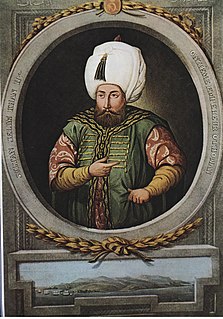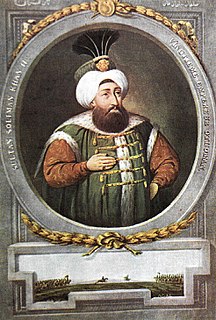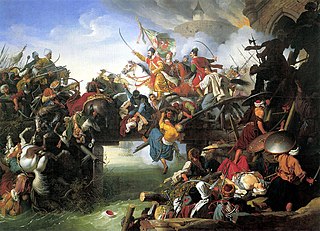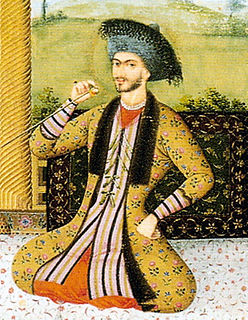Suleiman II may refer to:
| This disambiguation page lists articles about people with the same name. If an internal link led you here, you may wish to change the link to point directly to the intended article. |
Suleiman II may refer to:
| This disambiguation page lists articles about people with the same name. If an internal link led you here, you may wish to change the link to point directly to the intended article. |

Ahmed II was the Sultan of the Ottoman Empire from 1691 to 1695.

Suleiman I, commonly known as Suleiman the Magnificent in the West and Kanunî Sultan Süleyman in his realm, was the tenth and longest-reigning Sultan of the Ottoman Empire from 1520 until his death in 1566. Under his administration, the Ottoman state ruled over at least 25 million people.

Selim II, also known as Sarı Selim or Sarhoş Selim, was the Sultan of the Ottoman Empire from 1566 until his death in 1574. He was a son of Suleiman the Magnificent and his wife Hurrem Sultan. Selim had been an unlikely candidate for the throne until his brother Mehmed died of smallpox, his half-brother Mustafa was strangled to death by the order of his father, his brother Cihangir died of grief at the news of this latter execution, and his brother Bayezid was killed on the order of his father after a rebellion.

Louis II was King of Hungary, Croatia and Bohemia from 1516 to 1526. He was killed during the Battle of Mohács fighting the Ottomans, whose victory led to the Ottoman annexation of Hungary. He had no legitimate issue.

Suleiman II was the Sultan of the Ottoman Empire from 1687 to 1691. After being brought to the throne by an armed mutiny, Suleiman and his grand vizier Fazıl Mustafa Pasha were successfully able to turn the tide of the War of the Holy League, reconquering Belgrade in 1690, as well as carrying out significant fiscal and military reforms.

Hurrem Sultan, also known as Roxelana, was the chief consort and legal wife of the Ottoman Sultan Suleiman the Magnificent. She became one of the most powerful and influential women in Ottoman history and a prominent and controversial figure during the era known as the Sultanate of Women.

The Siege of Vienna in 1529 was the first attempt by the Ottoman Empire, led by Suleiman the Magnificent, to capture the city of Vienna, Austria. The siege came in the aftermath of the 1526 Battle of Mohács, which had resulted in the death of the King of Hungary and the descent of the kingdom into civil war, with rival factions supporting the Habsburg Archduke Ferdinand I of Austria and others supporting the Ottoman-backed John Zápolya. The Ottoman attack on Vienna was part of their intervention into the Hungarian conflict, intended in the short term to secure Zápolya's position. Historians disagree in their interpretation of Ottoman long-term goals and regarding what motivations lay behind the choice of Vienna in particular as the target of the campaign. The failure of the siege marked the beginning of 150 years of bitter military tension and reciprocal attacks, culminating in a second siege of Vienna in 1683.
Suleiman is the main transliteration of the Arabic سليمان Sulāymān / Silīmān. The name means "man of peace" and corresponds to the English name Solomon. The word may also be transliterated as Sulaiman, Suleman, Soliman, Sulayman, Sulaymaan, Sulyman, Suleyman, Sulaman, Süleyman, Sulejman, Sleiman, Sleman, Sliman, Slimane, Soleman, Solyman, SouleymaneSeleman. This disambiguation page focuses on individuals and entities with Suleiman as a predominant transliteration.

The Siege of Szigetvár or the Battle of Szigeth was a siege of the fortress of Szigetvár, Kingdom of Hungary, that blocked Sultan Suleiman's line of advance towards Vienna in 1566. The battle was fought between the defending forces of the Habsburg Monarchy under the leadership of Nikola Šubić Zrinski, former Ban of Croatia, and the invading Ottoman army under the nominal command of Sultan Suleiman the Magnificent.

The Classical Age of the Ottoman Empire concerns the history of the Ottoman Empire from the Conquest of Constantinople in 1453 until the second half of the sixteenth century, roughly the end of the reign of Suleiman the Magnificent. During this period a system of patrimonial rule based on the absolute authority of the sultan reached its apex, and the empire developed the institutional foundations which it would maintain, in modified form, for several centuries. The territory of the Ottoman Empire greatly expanded, and led to what some historians have called the Pax Ottomana. The process of centralization undergone by the empire prior to 1453 was brought to completion in the reign of Mehmed II.

Sam Mirza, later known by his first dynastic name of Safi II, and thereafter known by his more famous second dynastic name of Suleiman I, was the eighth Safavid shah (king) of Iran, ruling from 1 November 1666 to 29 July 1694.

Omar Mahmoud Suleiman was an Egyptian army general, politician, diplomat, and intelligence officer. A leading figure in Egypt's intelligence system beginning in 1986, Suleiman was appointed to the long-vacant Vice Presidency by President Hosni Mubarak on 29 January 2011. On 11 February 2011, Suleiman announced Mubarak's resignation and ceased being Vice President; governing power was transferred to the Armed Forces Supreme Council, of which Suleiman was not a member. A new head of intelligence services was appointed by the ruling Supreme Council. Suleiman withdrew from the political scene and did not appear in public after announcing Mubarak's resignation.

Mir Sayyed Muhammad Marashi, better known by his dynastic name of Suleiman II, was a Safavid pretender who managed to briefly become ruler of some parts of Iran from 1749 to 1750. He was in charge of the affairs of the Imam Reza shrine in Mashhad.

The Ottoman–Safavid War of 1532–1555 was one of the many military conflicts fought between the two arch rivals, the Ottoman Empire led by Suleiman the Magnificent, and the Safavid Empire led by Tahmasp I.

Haseki Sultan was the imperial title used for the chief consort of an Ottoman Sultan. Haseki sultan meant "chief consort" or "single favorite" of the sultan. In later years, the meaning of the title changed to "imperial consort". Hürrem Sultan, principal consort and legal wife of Suleiman the Magnificent, was the first holder of this title.

Lütfi Pasha was an Ottoman statesman, general, and grand vizier of the Ottoman Empire under Suleiman the Magnificent from 1539 to 1541.

Mihrimah Sultan was an Ottoman princess, the daughter of Ottoman Sultan Suleiman the Magnificent and his wife, Hurrem Sultan. She was the most powerful imperial princess in Ottoman history and one of the prominent figures during the Sultanate of Women.

Şehzade Bayezid was an Ottoman prince as the son of Sultan Suleiman the Magnificent and his legal wife Hurrem Sultan. After the execution of Şehzade Mustafa in 1553, Bayezid became the popular heir among the army. Throughout the 1550s, when Suleiman was already in his 60s, a protracted competition for the throne between Bayezid and his brother Selim became evident. Bayezid had fallen into disfavor with his father – who was angered by Bayezid's disobedience stemming from around the same years – as opposed to Selim. After being defeated in a battle near Konya in 1559 by Selim and Sokullu Mehmet Pasha, he fled to the neighbouring Safavid Empire, where he was lavishly received by Tahmasp I. However, in 1561, on the continuous insistence of the Sultan throughout his son's exile, and after several large payments, Tahmasp allowed Bayezid to be executed by agents of his own father.

The Siege of Kőszeg or Siege of Güns was a siege of Kőszeg in the Kingdom of Hungary within the Habsburg Empire, that took place in 1532. In the siege, the defending forces of the Austrian Habsburg Monarchy under the leadership of Croatian Captain Nikola Jurišić, defended the small border fort of Kőszeg with only 700–800 Croatian soldiers, with no cannons and few guns. The defenders prevented the advance of the Ottoman army of 100,000 toward Vienna, under the leadership of Sultan Suleiman the Magnificent and Pargalı Ibrahim Pasha.

The fall of Belgrade in 1521 is an event that followed as a result of the third major Ottoman attack on this Hungarian stronghold in the Ottoman-Hungarian conflicts at the time of the greatest expansion of the Ottoman Empire to the west. Ottoman Sultan Suleiman the Magnificent decided that the first targets of his military campaigns would be Rhodes and Belgrade, a place that his ancestor Mehmed II the Conqueror (1451-1481) failed to conquer. Suleiman launched his army in mid-May 1521, and the main objective of this march was to conquer Belgrade. The Hungarian state was almost in disarray and unable to effectively counter the Ottoman army. Unlike previous campaigns, the Sultan decided this time that the main direction of attack was to go from the Sava. To do this, the Ottoman army first had to capture Srem, which was eventually done. Belgrade defenders persisted in resisting, but due to lack of manpower and war material, they had to surrender the city on 28/29. August 1521. The fall of Belgrade showed the inability of the Hungarian authorities to oppose the expansionist policies of the Ottoman Empire, which would show their supremacy in the battle of Mohács Plain in 1526. After the defeat and breakdown of Hungary, the leader of the Christian struggle against the Ottoman penetration of Europe will become the Habsburg Monarchy, which will include Hungary. Belgrade would come under the rule of a Christian force only in 1688 when Maximilian Bavarian conquered it for Austria.